Badminton String Tension Guide: High vs. Low Tension (Malaysia)
After seeing so many injured wrists and broken strings, I decided to write this simple guide. It is designed for social players, parents, and beginners in Cheras, Petaling Jaya, and across Kuala Lumpur who want to understand how to choose the right tension safely. Mr Eric Chuar, a BSW Certified Stringer and Master Tour Stringer, explains the physics of the stringbed and why copying the pros might be hurting your game.
A guide to understanding string tension, power vs control, and arm safety for Malaysian players.
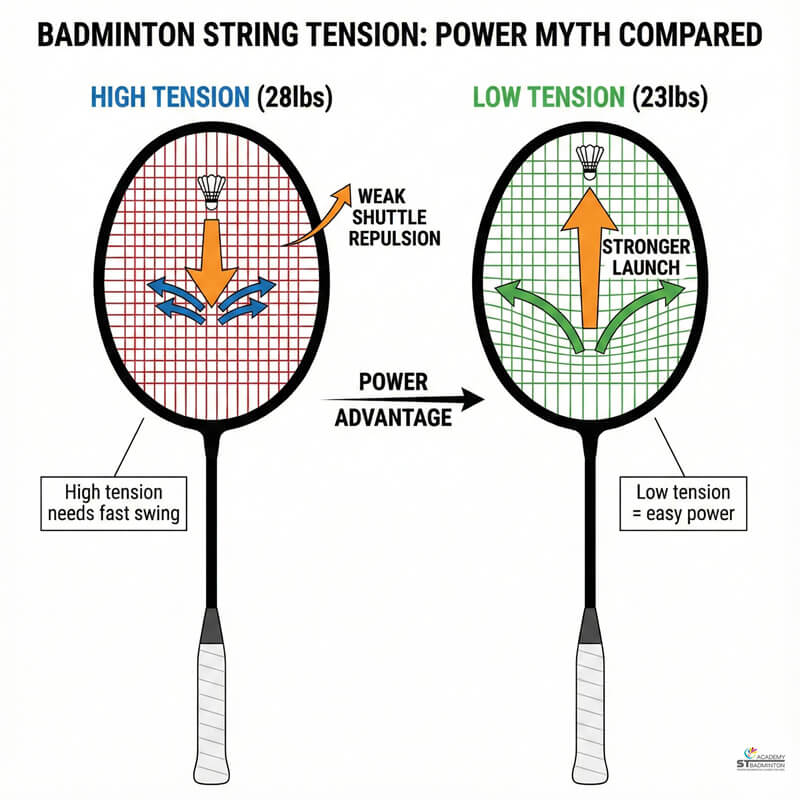
Tension Myth #1
Does Higher Tension Give More Power?
This is the most common misunderstanding among players in Cheras and Petaling Jaya. Many believe that pulling the strings tighter (e.g., 28lbs or 30lbs) automatically results in a harder smash. The reality is the opposite for most amateur players. High tension makes the stringbed feel like a hard board. If you do not have professional swing speed and perfect timing, the shuttle simply “bounces off” too quickly without generating repulsion.
Lower tension (e.g., 22–24lbs) creates a “trampoline effect.” The strings stretch and snap back, giving you easy power even if your swing is not incredibly fast. For beginners and social players in Kuala Lumpur, a moderate tension usually offers more accessible power for clears and lifts than a high tension setup.

Tension Myth #2
Is High Tension Better for Control?
Yes, generally high tension offers better control, but there is a catch. At higher tensions (above 26lbs), the stringbed becomes stiffer, providing crisper feedback and less “dwell time” for the shuttle. This allows accurate net shots and drives for players with precise technique. However, the sweet spot—the area where you must hit the shuttle—becomes very small.
If you are a developing player in Taman Connaught or Damansara who still hits off-center occasionally, high tension will punish you. Off-center hits on a high-tension racket feel harsh and have no power.
So, while high tension theoretically gives more control, it actually reduces control for beginners because it makes the racket harder to use effectively.

Tension Myth #3
Will High Tension Hurt My Arm or Wrist?
This is a serious concern. High string tension transmits more shock and vibration down the shaft to your hand, especially on off-center hits. If your arm strength or technique is not developed enough to handle this shock, it can lead to tennis elbow, wrist pain, or shoulder injuries.
As a BSW Certified Stringer, Coach Eric Chuar often advises parents and social players in Petaling Jaya to prioritize comfort over high numbers. Playing with a tension that is too high (e.g., 28lbs+) before your body is ready increases the risk of chronic injury.
A safer tension (22–25lbs) absorbs more impact and is generally much kinder to the joints, allowing you to play longer sessions without pain.
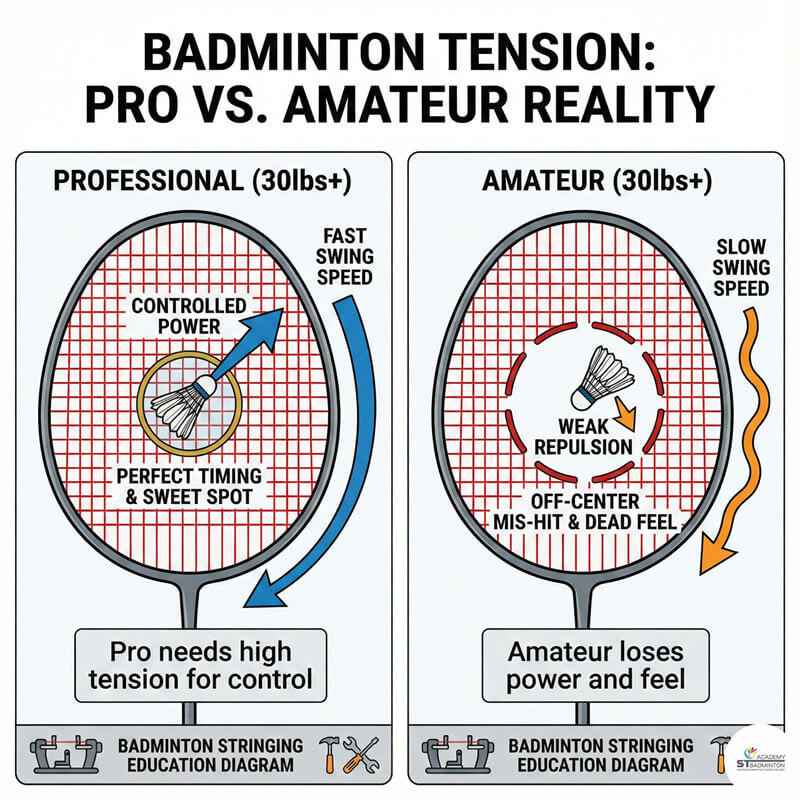
Tension Myth #4
Should I Copy My Favorite Professional Player?
It is tempting to ask for “Lee Zii Jia’s tension” or “Axelsen’s tension” at the stringing shop. However, pros train daily, have conditioned muscles, and break strings almost every match. Their 30lbs+ tension suits their extreme swing speed and need for millimetre precision. For a social player in Wangsa Maju or TTDI who plays once a week, using that same tension usually results in a “dead” feeling racket.
Instead of copying a pro, find the tension that matches your swing speed. If you struggle to clear from baseline to baseline, lower your tension. If you constantly hit the shuttle out because you have too much power, consider increasing it slightly (by 1lb or 2lbs).
Remember, the goal is to win your game, not to boast about a high tension number that hurts your performance.
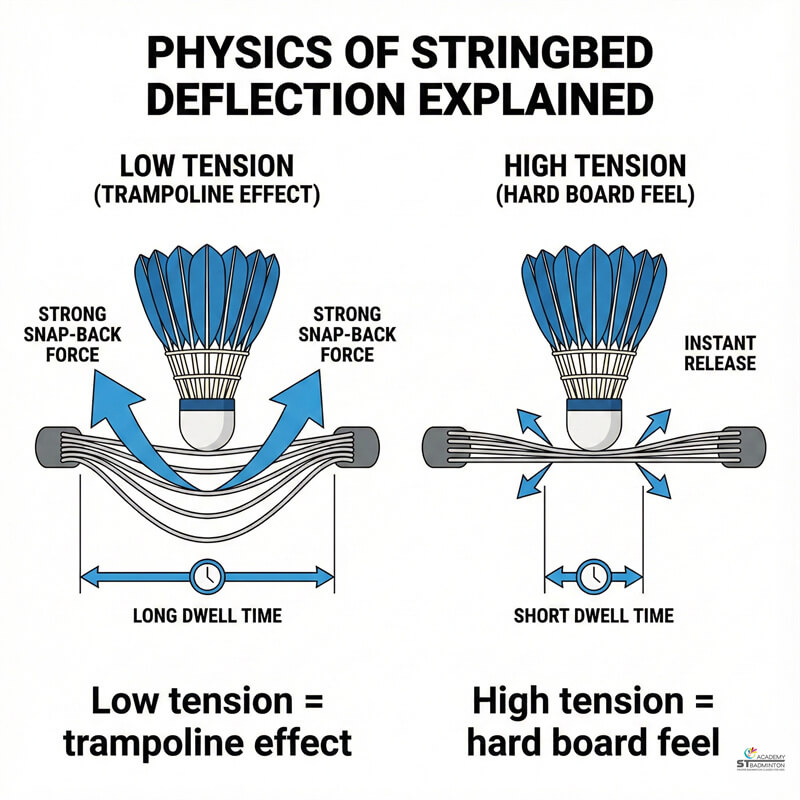
The Reality
What Actually Happens on the Stringbed?
When you hit a shuttle with low tension (e.g., 23lbs), the strings deflect more, creating a “pocket” that holds the shuttle for a split second before launching it out. This is the trampoline effect that generates easy power. It feels softer and makes a duller sound.
With high tension (e.g., 28lbs), the strings deflect very little. The shuttle leaves the bed almost instantly. If your swing is fast enough to compress the shuttle against this hard surface, you get a loud “explosive” sound and precise control. But if you swing slowly, the shuttle just bounces off weakly. String thickness (gauge) also matters; thinner strings (0.65mm) generally feel harder and more repulsive than thicker strings (0.70mm) at the same tension.
Factors like hall temperature and humidity in Malaysia also affect tension. Strings tend to lose tension faster in hot conditions, so what feels tight today might feel loose in two weeks.
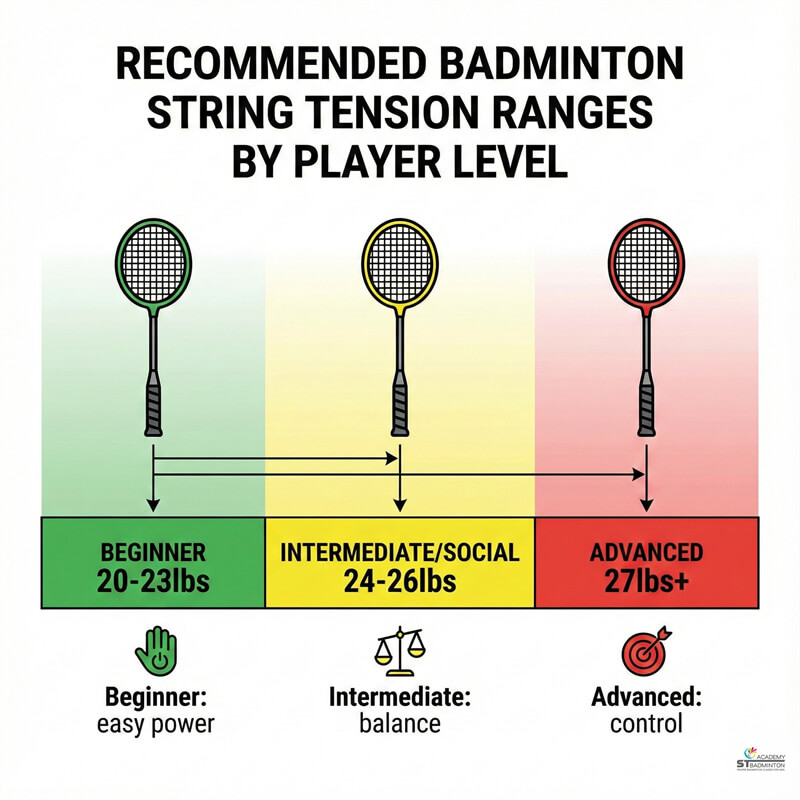
Quick Summary
Who Should Use Which Tension Range?
Beginners (20-23lbs): Focus on durability and easy power. You need a large sweet spot to help with mistimed shots. Intermediate/Social (24-26lbs): A good balance. You start to get more feel and a sharper sound without sacrificing too much power.
Advanced/Competitive (27lbs+): For players in leagues or state training in Cheras and PJ with strong wrists and consistent technique. Prioritizes control and feedback over power. Always adjust slowly—jumping from 24lbs to 28lbs instantly is a recipe for a broken frame or a sore shoulder.
Consult a certified stringer if you are unsure. Your string choice (0.66mm vs 0.70mm) will also shift these ranges slightly.
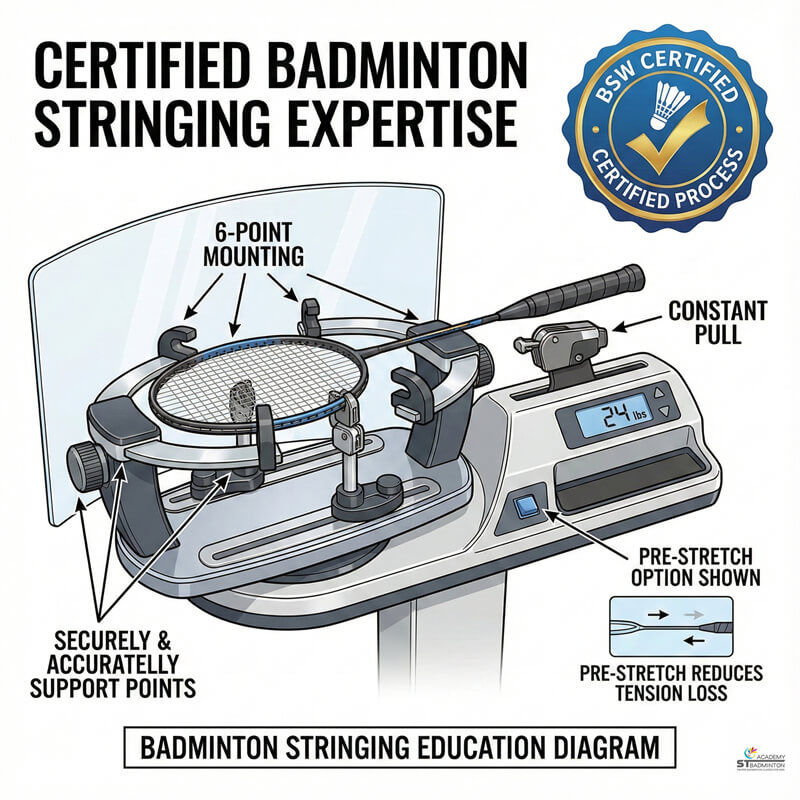
Why Trust Us
Certified Stringing Expertise in Kuala Lumpur
There are many stringers in Cheras, Setapak and Petaling Jaya, but few understand the science behind it. Coach Eric Chuar is not just a coach; he is a Certified Stringer and Master Tour Stringer under Best Stringer Worldwide (BSW). This means his advice is based on professional standards and a deep understanding of frame stress and string physics.
We help players from areas like Taman Maluri and Kepong find their optimal tension, ensuring that their equipment enhances their game rather than causing injury.
When you restring or train with us, you get advice tailored to your specific level, frequency of play, and physical condition, ensuring long-term enjoyment of the sport.
FAQs: Badminton String Tension in Kuala Lumpur
Answers to common questions from players in Cheras, Petaling Jaya and KL about choosing the right tension.
What badminton string tension is suitable for a beginner in Cheras?
For most beginners in Cheras and nearby areas, a tension between 20lbs to 23lbs is ideal. This lower tension provides a larger sweet spot and more “trampoline” power, making it easier to hit clears from the baseline. At ST Badminton Academy Malaysia, our BSW Certified Stringer recommends starting low to build correct technique before increasing tension.
Is high badminton string tension better for power or control?
High tension (27lbs+) is better for control but makes power harder to generate. It offers a stiff, crisp feel that good players love for net shots. However, if you lack swing speed, high tension kills your power. Low tension (22-24lbs) is better for easy power and comfort. Players in Petaling Jaya should choose based on their skill, not myths.
If I play league games in Petaling Jaya, how many lbs should I try?
If you are playing competitively in leagues around Petaling Jaya or Damansara, you might try 25lbs or 26lbs for a balance of control and power. This “medium” range is excellent for doubles players who need speed and snap. Don’t jump straight to 28lbs; increase by 1lb at a time to let your arm adapt to the vibration.
Will going from 24lbs to 28lbs suddenly damage my racket or arm?
It is risky. A sudden 4lb jump puts huge extra stress on the racket frame (risk of cracking) and your joints (tennis elbow). Our BSW Master Tour Stringer in Kuala Lumpur advises small steps. Also, string gauge matters—a thick string at 28lbs feels harder than a thin string. Always consult a professional before making big changes.
How often should I restring my racket if I play weekly in KL?
Strings lose tension (creep) over time, even if they don’t break. In the hot climate of Kuala Lumpur and Cheras, strings can lose “feel” after 2-3 months. If you play twice a week, restringing every 3 months keeps performance consistent. Playing with “dead” strings forces you to hit harder, which can hurt your arm.
Does string tension affect the sweet spot size?
Yes, significantly. Lower tension allows the stringbed to deform more, effectively creating a larger sweet spot. This is why beginners in Setapak and Wangsa Maju should use lower tension; it is more forgiving on off-center hits. High tension shrinks the sweet spot, demanding near-perfect timing on every shot.
Where can I get professional stringing advice in Malaysia?
You can visit ST Badminton Academy Malaysia in Kuala Lumpur. Coach Eric Chuar is a BSW Certified Stringer and Master Tour Stringer. We serve players from Cheras, Petaling Jaya, Kepong, and surrounding areas who want honest, safe advice on string tension charts and racket maintenance.
Why does my racket feel like a board at 28lbs?
At 28lbs, the stringbed is very stiff and has almost no “trampoline” effect. Unless you have a very fast, snapping swing to flex the stringbed, the shuttle just hits a hard surface and dies. Players in malls like Sunway Velocity or sports halls in KL often experience this when they copy professional specs without having the physical strength to utilize them.
Do thinner strings break easier at high tension?
Yes. Thinner strings (e.g., 0.65mm or 0.66mm) offer great repulsion and sound but are less durable, especially at high tensions like 28lbs. If you play frequently in Cheras or TTDI and mishit near the frame, a thin string at high tension will snap very quickly. Thicker strings (0.68mm-0.70mm) are safer for durability.
String Tension & Performance in Action
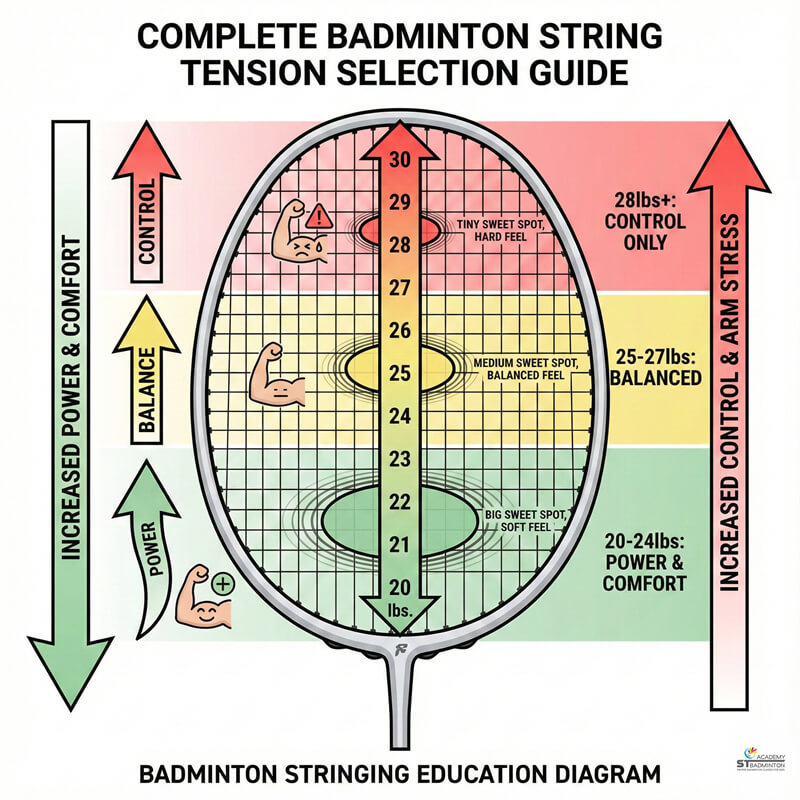
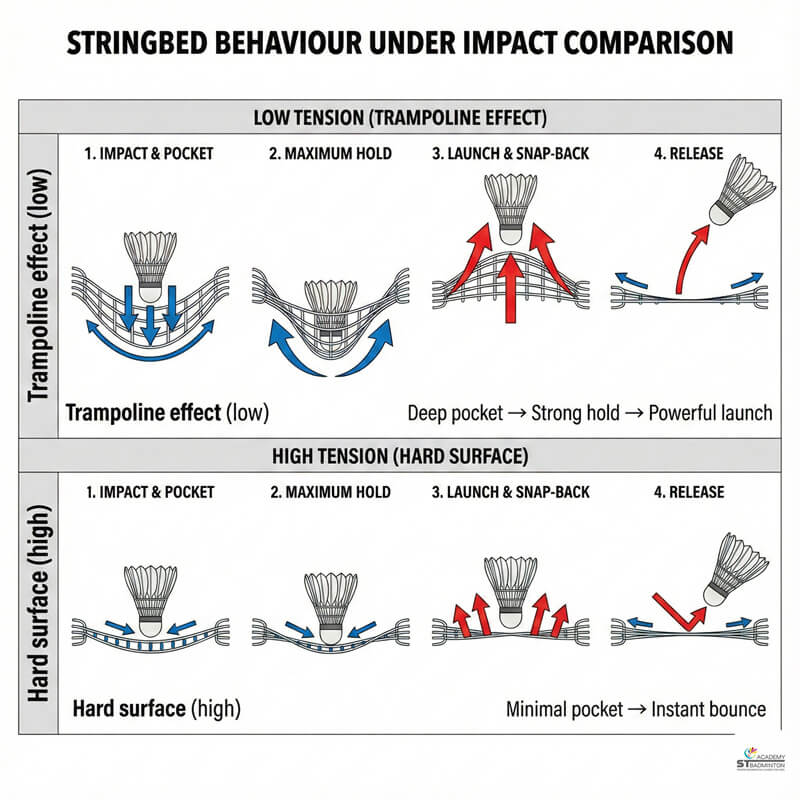
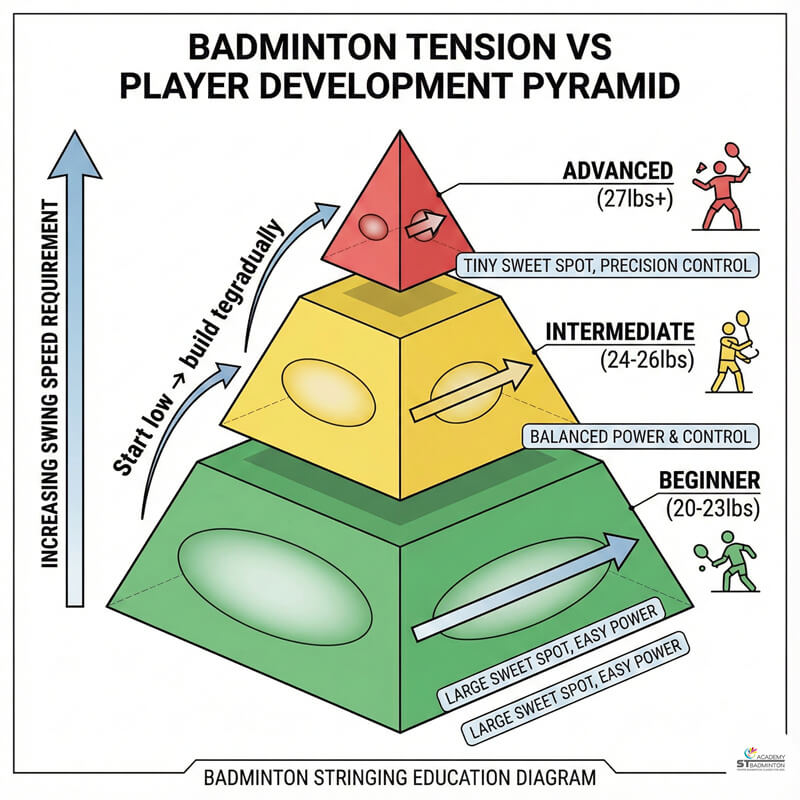
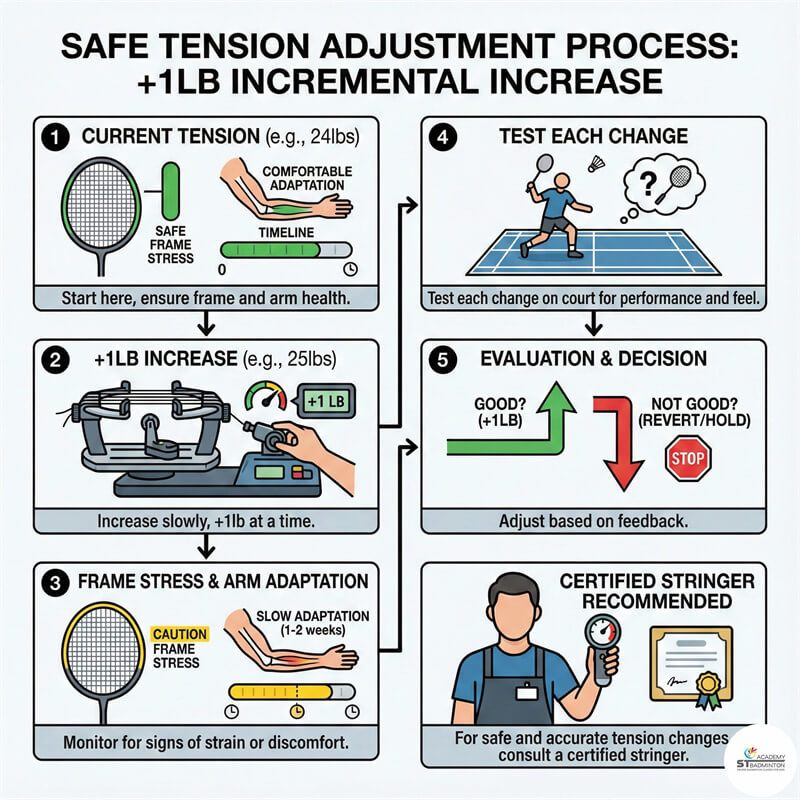
Benefits of Correct String Tension Choice
Choosing the correct tension transforms your game. It prevents injury, improves your clears, and makes badminton fun again. Our BSW Certified Stringer helps players in Cheras and Petaling Jaya find that perfect balance.
| Characteristic | Low/Medium Tension (20-24lbs) | High Tension (27lbs+) ADVANCED |
|---|---|---|
| Sweet Spot Size | Large and forgiving. Easier to hit clean shots even if off-center. | Small and concentrated. Requires perfect timing and accuracy. |
| Power Generation | Trampoline effect generates easy power. Good for clears and lifts. | Repulsive power. Requires strong wrist and fast swing speed to activate. |
| Control & Feedback | Softer feel, less precise feedback. Shuttle holds on stringbed longer. | Crisp, sharp control. Excellent for net shots and precise drops. |
| Vibration & Shock | Low shock absorption. Gentle on the arm, wrist, and elbow. | High shock transmission. Can cause injury if technique is poor. |
| Durability | Strings last longer. Less stress on the racket frame. | Strings break easier (especially thin ones). Higher risk of frame cracks. |
| Sound | Duller, softer thud. | Loud, high-pitched explosive sound (if hit correctly). |
| Best For | Beginners, social players, juniors, and players with arm pain. | State players, professionals, and advanced players with strong technique. |
Stringing & Coaching for Players in Cheras & PJ
Don't let the wrong string tension ruin your game or hurt your arm. ST Badminton Academy Malaysia offers professional stringing advice and coaching by a BSW Master Tour Stringer. Whether you are from Cheras, Petaling Jaya, Kepong, or Kuala Lumpur, contact us to find the perfect setup for your level.




